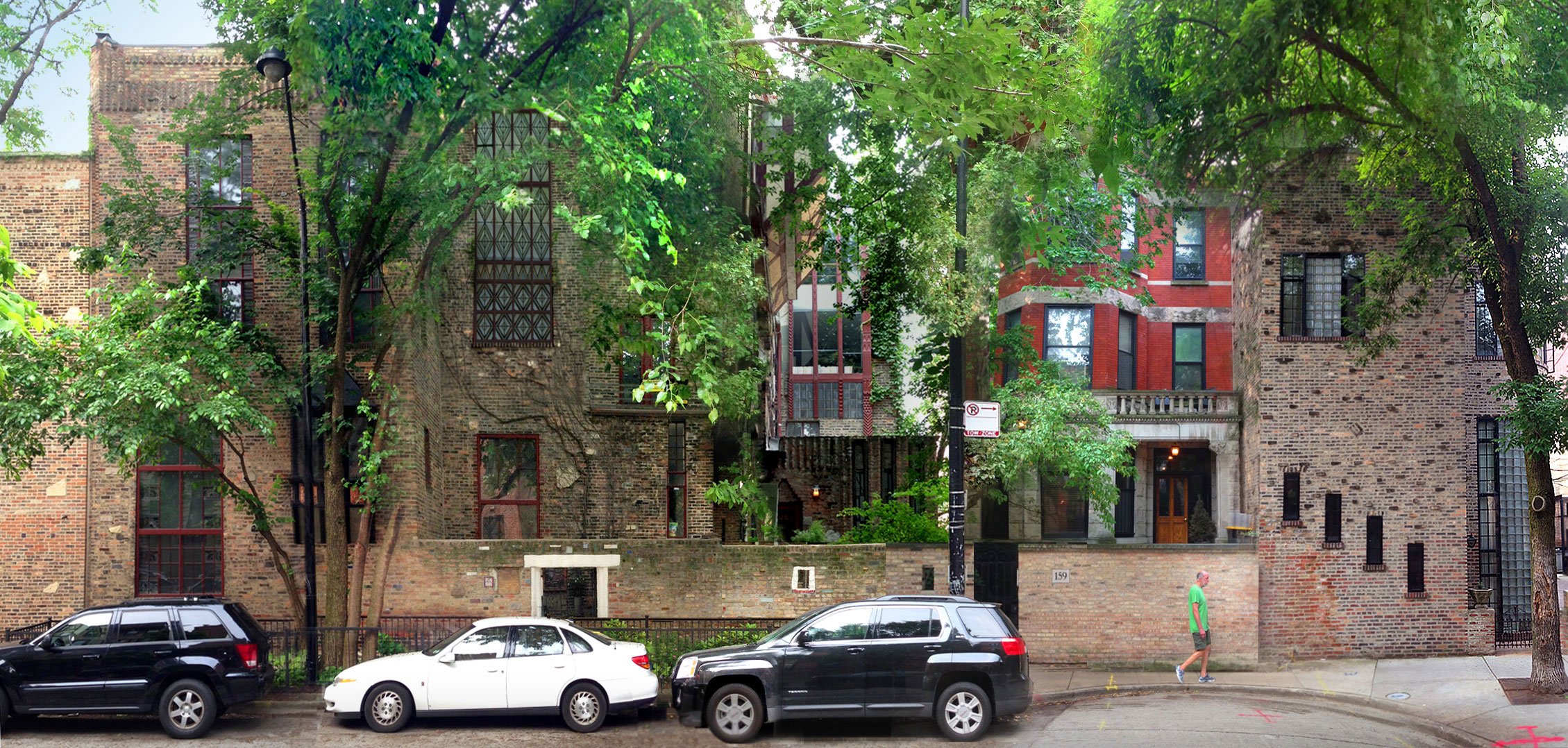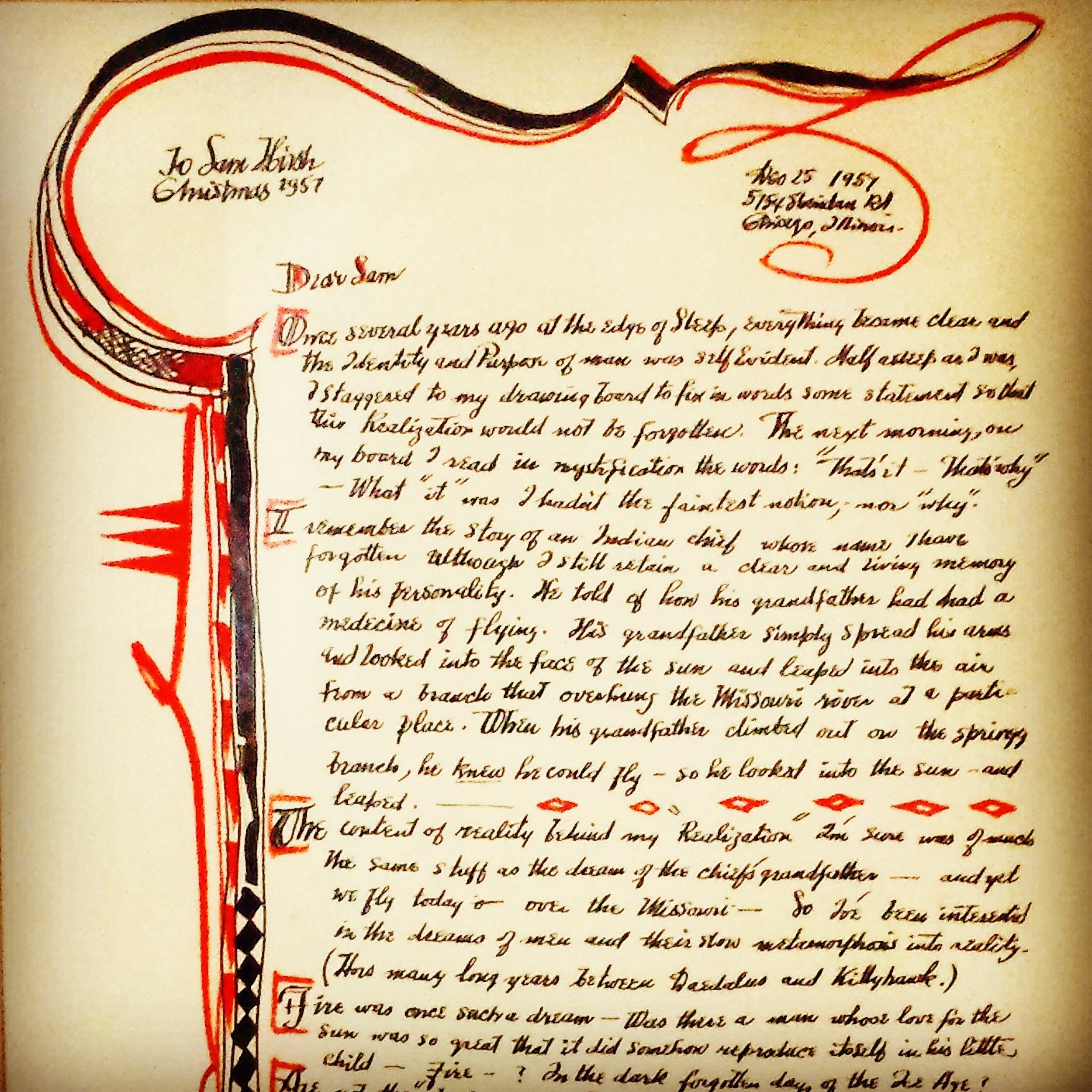Edgar Miller
A Visionary of the Twentieth Century
Edgar Miller working on a study for cast plaster sculptures commissioned for U.S. Gypsum c. 1963.
In a modern age, Edgar Miller embraced old-world skills with hands that mastered dozens of media of art, design, craftwork, and architecture.
Born two weeks shy of 1900 on the western frontier of the United States in Idaho Falls, Idaho, Edgar Miller produced art almost every day of every decade in the twentieth century. Largely self-taught, Miller was an artistic polymath, whose artwork was marked by spontaneity, originality, resourcefulness and workmanship. He moved to Chicago at the age of seventeen to study at the renowned School of the Art Institute, and also began to work alongside many of the great commercial designers and architects of the Midwest of that era, including Andrew Rebori, Alfonso Iannelli, and craftworkers of Jane Addams’ Hull-House. In the 1920s, he was called “the blond boy Michelangelo”; in the ‘30s, “a new luminary” by Architecture magazine; in the ‘40s, “one of the most versatile artists in America.”
By the 1950s, he was the go-to guy for the nation’s most successful industrial designers. Later in life, he proudly considered himself a “big thinker.”He was a trained fine art painter, a master woodcarver, and one of the nation’s foremost stained-glass designers. He could sculpt in stone and plaster, draw portraits and murals, and he was considered a pioneer in the use of graphic art in advertising. Miller’s style referenced styles as diverse as Medieval Gothicism, Mexican Modernism, French Expressionism, and American Art Deco. His skill and talent were well recognized in his time. He is now largely overlooked by contemporary audiences because his work does not fit into a single artistic tradition or style. And because his art was meant to hang not in museums but in the handmade homes he created.
Construction photo of the remodeled exterior and facade of what would become the Carl Street Studio complex, designed by Edgar Miller, c. 1927.
The West Burton Place Historic District block today, c. 2015.
Details of exterior wall windows, highlighting Miller’s cast ceramic and wood work.
Edgar Miller’s approach towards art was best exemplified ultimately by the project of his “handmade homes,” through which he was able to create environments that were total works of art.
Miller’s genius reached its apex in four fully realized artistic studios that he built on Chicago’s North Side in the 1920s and ‘30s. Miller marked almost every inch of the studios with daring and surprise. He took rustic brick, crude stone, salvaged tile, found glass and recycled steel and wood and “Edgarized” the homes, packing them with stained-glass windows, frescoes, murals, mosaics and woodcarvings. He worked on the homes with the same fervor that Antonio Gaudí brought to his Barcelona church or Simon Rodia to Watts Towers.
Many of these homes were designed as built-environments and live-work communal spaces for artists. Dozens of creative professionals from a variety of fields have called these places home. Remarkably, Miller’s handmade homes still stand today. Many owners of these spaces have endeavored to keep Miller’s architectural masterpieces preserved as original as possible. While the homes have changed over the decades—refurbished often in the image of Miller’s original design—maintaining the legacy of his intended spirit.
In the manner of England’s William Morris, the founding master of the arts and crafts movement, Edgar Miller strove to create a total work of art in his four houses. Miller’s homes are the equivalent of Morris’s nineteenth-century Red House in suburban London. Morris emphasized craftsmanship because he rejected the machine age. Miller embraced craftsmanship to honor the natural world. As had Morris with his Red House, Miller created environments that were “more a poem than a house, but admirable to live in, too.”
Miller—like Morris—was a doer, not afraid to try anything artistically. “If you don’t change the air in your lungs, you die,” he once said. “If you do not experience all the changes in growth from childhood to maturity, you are a moron.” That was how Miller talked: in absolutes, with the distinct western lilt of his childhood and a confidence he developed over the years. On the surface, art seemed to come easily to him, but he worked at it every day. Attempting to master so many mediums took courage. “Your rationalizations will give you good reasons not to do things,” he confided to a young friend in the 1980s. “Rationalization is a thing that can destroy courage, particularly where something has to be decided. There’s always a damn good reason why you shouldn’t do things, and you either have to give in to it or break through it. Every time you break through it I think it’s easier the next time.”
Because he caught on quickly to the inherent nature of materials and could organize a two- or three-dimensional space in a totally unaffected manner, Miller was able to work in dozens of disciplines and multiple styles. “I accepted influences from any place,” he wrote unabashedly. But like any accomplished artist, he processed what he saw and made it his own: “Influence is nothing but nourishment, and you grow by it,” he wrote. “To be afraid of influence is like being scared to eat.”
In the end, Miller, along with business partner Sol Kogen, architect Andrew Rebori, and fellow artisan Jesús Torres would work on four rehabbed and original handmade home buildings: the Carl Street Studios, the Walter Guest Apartments, the Fisher Studio Apartments, and the Kogen-Miller Studios (home to Miller’s masterwork, the Glasner Studio).
Edgar Miller’s Philosophy
One incredible bonus to researching the life of Edgar Miller is the copious amounts of writing he did on all matter of subjects. Art, obviously, was a major source of inspiration for putting his thoughts on paper. Yet he also wrote about many other subjects, like history, politics, and the evolutionary nature of humankind.
One such writing he considered so profound that he wrote it out as an elaborate scroll, with decorated margins and beautiful calligraphy, and sent it to his friend Sam Hirsh.
We have transcribed the piece below so you can read it for yourselves. It certainly has a prophetic tone: What are we here for? Is Art the reflection of our love of Nature? Are we all just cells in an even larger organism creating itself to become a unified Earth?
Handwritten letter to friend Sam Hirsh from Edgar Miller, December 25th, 1957.
Without using the word, he seems to be predicting the idea of Singularity, which was bubbling up amongst many futurist thinkers starting in the 19th century and taking a much more realistic quality at the beginning of the Computer and Space Age after World War II.
It is remarkable that Edgar thought so deeply on this subject, and it speaks to his nature not simply as a talented and proficient artist, but also as a truly great mind.
Edgar Miller at a craft showcase highlighting his work, c. 1960.
Edgar Miller’s creativity centered on a simple message: nature is a science that shouldn’t be defied, and the world should respect and learn from nature.
It was a lesson learned from his father, a beekeeper rewarded with bounty for making life easier for his bees, and as a boy headed to the lava fields of Idaho on expeditions with his brother. The flowers and fauna young Edgar encountered became the building blocks of his art, his lifelong motif. Miller’s admiration of nature was so basic that at first it did not seem profound, but it was a theme that occupied him all his life. “Why animals?” he was asked in 1989 by a woman curious about the creatures that dominated his art. “To me, they are life,” he replied.
Miller was not an environmental visionary but a practical man who learned from those who made use of every last piece of material. That’s how Miller built his homes, by turning discarded bathroom tiles into a new roof and rearranging salvaged brick to create ornamental walls. Miller’s recycled houses point to a new architecture, but it has taken us decades to fully understand them. Miller found beauty and utility in reusing material and thought it tragic that we were tossing out so much. “I’ve seen the lake in Chicago as a beautiful, clear body of water that you could dip a tin cup in and drink from,” he said, “and now I see it floating with dirty newspapers and garbage. No bird defiles its own nest. Man is the only stupid ass that does that.”
Miller understood that he was born with a gift, and he felt a lifelong responsibility to use his skill to communicate what was inside him. “The artist takes impressions from life about him, reorganizes them within himself to have form and meaning, then expresses them,” he wrote. His entire life was a never-ending search for the meaning of art. Near the end, he believed he had grasped the secret he had long sought, but he was frustrated that he could never adequately put his thoughts on paper. “It’s not that I feel the artist to be a ‘superior’ kind of creature, merely one that has reserved judgment until he sees the whole picture,” he wrote. “It may take more than one lifetime.”
From Edgar Miller and the Handmade Home, by Richard Cahan and Michael Williams with Photos by Alexander Vertikoff.
Published by City Files Press, 2009.
Some of Edgar Miller’s earliest non-commissioned stained glass windows, installed at the Glasner Studio, c. 1928.






